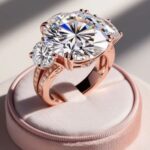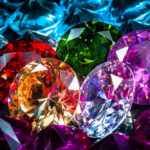Short answer gem of june
Gem of June is a birthstone for individuals born in the month of June. It is commonly known as Alexandrite – a rare and valuable stone that changes color from green to purple when viewed under different lighting conditions. It symbolizes love, affection, and prosperity.
How to Identify and Choose the Perfect Gem of June
June is undeniably one of the best months when it comes to gemstones. The month of June boasts multiple luxurious birthstones that are sure to catch your eye and tickle your fancy – pearls, alexandrite, and moonstone. These three stones are a perfect representation of nature’s beauty with their unique properties playing perfectly off each other for those who like to mix and match.
Identifying these gems require more than visually inspecting them at first glance or relying excessively on information sourced from others’ opinion. For instance, in terms of identifying a pearl, coloration does not always determine its authenticity; rather the thickness pf nacre determines if it’s genuine.
To properly identify a jewel stone such as alexandrite requires professionals because this specific mineral comprises chromium that gives it an exceptional hue change capability uncommon among other minerals under illumination variations ranging from daylight source colors into artificial light hues.
Moonstone carries various types: grayish-blue cabochons exhibiting adulators unique multicolored flashing effects throughout milky white body-type appearance
The combination of how subtle yet striking these characteristics are makes choosing between any or all three gems of June most tricky task!
When decided on which stunning jewelry piece to buy as referenced above, you may want to consider the following:
1) What will be the primary purpose of owning this particular gem?
2) Will it suit your skin tone?
3) Does the cut match your style?
When weighing options regarding caring for any personal adornment originatign from these valuable materials tips include;
a) Ensure not exposing ornaments during rigorous activity wear gloves while performing household tasks where hands come into contact with chemicals capable corroding surface luster values especially pearls rich ‘nacre coatings’ susceptible ruin via acidic agents found cleaneers.
b.) refrain from direct exposure sunlight uv radiation distances better stored felt-lined compartments whereas avoiding pressure scratch damage minimize fracturing risks.
In conclusion, with proper care, either of the gems: pearls, alexandrite or moonstone choice is a perfect addition to your collection. As important as beauty in gems hold one needs to prioritize the authenticity and other significant properties above all else for guarantee values beyond marveling ‘attractive appearances if interested resale possibility arises. Although luxury often comes at a cost choosing any June’s birthstones remains an excellent investment that holds great value lasting lifetimes!
Step-by-Step Guide on Incorporating Gem of June into Jewelry Pieces
June is the month of summer solstice, and what better way to celebrate than by incorporating one of nature’s most beautiful creations –the gemstone Alexandrite- into your jewelry pieces! It sparkles with its color-changing hue that varies from green to purple depending on the light source. In this step-by-step guide, we will give you expert tips and tricks on how to incorporate Gem of June into jewelry pieces.
Step 1: Choose Your Design:
First things first; decide what style of jewelry you want. Whether it’s a ring or pendant, choosing your design determines the size and cut you need for your gem. Some popular designs are halo rings or single stone drop necklaces.
Step 2: Select your Alexandrite
This is where all the fun begins! Browse through different shapes like cushion-cut round or oval-shaped stones available at reputable jewelers such as Blue Nile or James Allen. When selecting an Alexandrite make sure it has good clarity and depth in its tone, these qualities enable it to change colors beautifully under any lighting condition.
Step 3: Find A Setting That Compliments The Stone
The right setting can bring out the best in Alexanadrites’ unique color-changing properties while also accentuating other embellishment details within the piece. For example,simple gold prongs on either side could amplify contrast between stone colors while pave diamond encrusted borders add sparkle and scintillation.
Step 4: Discuss Customization Options With Expert Jewelers
Here’s something every aspiring jeweler should know when empowering themselves with proper designing knowledge – successful customizations typically result from clear communication with experts who understand how different factors align seamlessly in creating customized accessories even those beyond price tags. Be specific about materials (like platinum) be mindful regarding effects maintenance usage so they can help create precisely what you’re looking for!
Finally
Congratulations! You have successfully incorporated Alexandrite into a stunning piece of jewelry that will stand the test of time. Alexandrite is a rare gemstone that has mesmerized jewelry enthusiasts for generations due to its unique and color-changing properties, making it one of June’s most sought-after stones. By using this guide and taking these expert tips into consideration, you’ll create an exquisite piece that will wow all who lay their eyes on it.
Common FAQs About the Gem of June Answered
June is a month that brings with it the warmth of the sun and the beauty of blooming flowers. It’s also perfectly characterized by its birthstone, the strikingly gorgeous pearl.
With its exquisite aura and legendary significance, pearls are known to be one of the most valuable jewels on earth. But despite their alluring charm, there’s still so much that people don’t understand about them.
To help clear up some of that confusion, we’ve put together some FAQs about June’s gem – pearls!
1) What exactly is a pearl?
A pearl is an organic mineral formation created inside living mollusks like oysters or mussels when something (usually sand or other irritants) finds its way into these shells. The mollusk then covers this irritant with layers upon layers of nacre (a composite made primarily from calcium carbonate). Over time, this process creates a stunningly beautiful round shimmering iridescent sphere – better known as a pearl.
2) Are all pearls white in color?
Contrary to popular belief-pearls come in various colors! These can range from cream or peachy-pink hues to vibrant greens and blues; however be rest assured irrespective of which shade you preference pearls always exude understated elegance!
3) What factors determine how valuable a pearl is?
The price tag on pearls varies considerably depending on different attributes such as size(also referred to carat weight), rarity, shape(uniformity), freeness from blemishes(lack luster!) amongst others similar criteria
4) Can you detect if it’s real or fake using any tests at home?
Definitely not unless if you’re trying outdated methods from “Magnum P.I.” In actual fact spotting between real and plastic faux versions have become ever more complex due advanced tech used replicating exact physical properties within synthetic copies making even trained appraisers struggle sometimes without resorting sophisticated Gemological testing techniques
5) How can you clean and store pearls?
Firstly avoid harsh chemicals or abrasives when cleaning them. Just gently rinsing it with a delicate soap or warm water is sufficient, thereafter always dry well before storing in jewelry bag away from overexposure to sunlight and other spurious elements.
In conclusion-By virtue of their durability & longevity, Pearls have fascinated both gem enthusiasts alike for centuries; The rare fusion of its simplistic beauty and thought-provoking creation process weave together into an astonishing marvel that captivates attention timelessly. So this June if you’re looking out on how mindful gifting ideas look no further than the timeless pearl!
Top 5 Fascinating Facts About the Gem of June
As June comes around, the birthstone of the month remains one of the most beloved and cherished gems. The pearl has always held a special place in people’s hearts throughout history because it symbolizes purity and innocence. However, there are other lesser-known aspects to this beautiful gem that make it all the more interesting. Here are five fascinating facts about pearls:
1. Pearls Are Not Just White – While white pearls may be the most commonly known variety, these precious stones come in many different colours such as rose pink, golden yellow and even black! These differences occur due to several factors like where they grew or what kind of mollusc produced them.
2. Natural Pearls Are Rare – Out of every million oysters, only one may produce a natural pearl! This rarity is why almost all pearls we see on jewellery today are cultured with human intervention to stimulate their growth process.
3. Pearly Gates? – According to Christian mythology, when St Peter greets souls entering heaven he holds keys made from mother-of-pearl so his Heavenly abode must have an extra sparkle!
4. Cleaning Tip: Avoid Chemicals – One little hot tip for keeping your pearl strands clean? “Put them on last after applying makeup and hair products” Pearls skin absorbs chemicals quickly causing discoloration over time exposing them to chemicals can damage both their luster & colour
5. Pearl Substitutes Exists Too! Love pearls but cannot afford real ones? You’re not alone! Luckily though there exist substitute options like Swarovski crystal pendants or glass-based Japanese Akoya which look remarkably similar yet won’t break your wallet unlike its organic counterpart.
In conclusion, these snippets barely scratch the surface regarding information available when discussing these captivating stones– each with unique characteristics making them stand out from any other jewels ever discovered; pearls really do come in all shapesand sizeswhich is evident byadmiringthe various huesfromnature’s mollusks. Whether you own the genuine article, a stunning cultured variation or prefer one of its imitations – they remain one of the most sought-after and classical pieces to treasure for years.
The Significance of Giving a Gem of June as a Gift
June is a magical month for many reasons. It marks the beginning of summer, school holidays and much-anticipated vacations. But there’s more to this special month than just fun in the sun – it’s also home to one of the most enchanting gemstones: The Pearl! Giving a pearl as a gift has been cherished over centuries because of its symbolism and unique properties.
The pearl, known as “Queen Gems” (Mukta) in ancient India, has always been associated with royalty and nobility. Nobles showed off their pearls during royal gatherings and family events, while wealthy merchants purchased them for extravagant gifts. In addition to wealth & status symbolism, the pearl was also believed to have healing properties – protecting from evil spirits & boosting fertility.
One particular tale surrounding pearls is that they’re born of lightning strikes hitting oysters in water sources such as rivers or seas which no doubt increased its mystique throughout time; becoming traditional wedding day jewelry gifting brides ever since.
Today though, pearls are not limited only to royal families but rather anyone can own them given we now have commercial farms producing cultured freshwater gems making Pearls both accessible and affordable…with all those well-proven benefits intact.
Now you can see why presenting someone with stunning June birthstone jewelry makes an enduring and meaningful gesture!
Aside from being 33rd anniversary presents along with Alexandrite stones by modern conventions whilst turquoise association dates back before medieval times honoring Ancient Egyptians’ use regularly through religious ceremonies/gifts”, putting thoughtful consideration into your special someone’s commitments is incredibly appreciated .
Giving pairings centered around creativity like hand-knotted necklaces made up white/beige/cream hues softly shining against summer clothes may inspire tranquillity — perfect when trying clam nerves right before important meetings/events.
Triple-tiered dangle earrings pronounced with lustrous sheen awash blues accentuate reflective light emitting beauty refracting beautifully rendering amplified femininity creating womanly sensuality highlighting femininity.
Maybe it’s a long time friend that expects nothing but surprises nonetheless they deserve some recognition too. A jewelry piece boasting an oversized pearly centerpiece perhaps paired with amethyst or similar rare stones would represent best their authenticity, allowing them to speak out among peers drawing admiring conversations around them.
That all brings us back to the idea of pearls as special and unique gifts. Their stunning appearance is matched only by their deep symbolism – representing purity beauty in harmony with effortless luxury making for refined yet practical style.
So next time you’re looking for the perfect gift for someone special (or yourself!), consider giving a birthstone of June – pearl! You’ll adore its timeless allure reflecting your choice forevermore, reminding both giver and receiver every milestone marked together & celebrated through one-of-a-kind heirloom treasure passed down from generation to generation ensuring love remains present throughout years passing…and what could be more important?
Different Cuts and Settings for Maximizing the Beauty of Your Gemstone: A Practical Guide
As any jewelry lover or gemstone enthusiast knows, how a stone is cut and set can have a major impact on its overall appearance. The way light interacts with the facets and angles of a gem can either enhance or detract from its natural beauty. And of course, the setting itself plays a crucial role in showcasing the stone to its best advantage.
So what are some key factors to consider when choosing cuts and settings for your precious gems? Let’s dive into some practical tips that will help you maximize their beauty and value.
First off, let’s talk about cutting styles. There are many different types of cuts out there, but we’ll focus on three popular ones: round brilliant, princess cut, and emerald cut.
The round brilliant is perhaps the most classic style of all – it features 58 meticulously arranged facets that allow maximum light to enter and reflect back out through the top of the stone. This type of cut works well for diamonds as well as other gemstones with high refractive indices (i.e., ability to bend light) such as rubies and sapphires.
The princess cut, on the other hand, has become increasingly popular over recent years due to its modern look – it features straight edges rather than curves like those seen in round brilliants which gives it an angular appearance while still having strong sparkle qualities.
Finally, there’s the emerald cut – named after one often used for emeralds; this style has fewer faceted surfaces than others so reflections are less complex. Rather than brilliance being created by multiple lights reflecting between asymmetrical angles within each face like a round brilliant cut would provide; an alternating pattern was chosen where traditional rectangular-shaped areas separate larger bars meaning more shallow reflections under bright conditions making them far more suitable for people who love clarity over resplendence .
Each shape shows differently not only amongst stones but also according personal preference so experimenting before purchasing is always recommended!
Now let’s talk about settings – this is the way in which your stone will be secured into its piece of jewelry. There are a variety of settings to choose from, each with their own benefits and drawbacks.
The most common setting seen for rings is known as prong setting because it allows light to pass through from all angles while holding the stone securely. A bezel set ring holds a gem by being surrounded with metal on top such that only what can be seen horizontally comes visible – thin strips around an outline creating modern looks or thicker styles enhancing vintage designs when workings softer metals like gold vs platinum but both great at showcasing aspect ratio. Channel sets keep stones secure by placing them between two adjacent walls where they may vertically pop out if not too high.
In general terms, a sedate white gold Claddagh Band would look well-complemented by some kind of solitaire design (for stunning simplicity), whilst more ornate options might include marquise stones within halo frames.”
Ultimately, how you choose to cut and set your gems should depend on factors such as personal taste ,the type of stone you have selected, whether durability versus delicacy matters more amongst other considerations; however seeking advice from professional jewelers who specialize in bespoke pieces & make practical suggestions given individual lifestyles was strongly recommended allowing for optimization without compromise!
Table with useful data:
| Type of Gem | Color | Origin | Hardness (Mohs) |
|---|---|---|---|
| Pearl | White | Oysters | 2.5-4.5 |
| Moonstone | Colorless, white, gray, peach, pink, green | Sri Lanka, India, Brazil | 6.0-6.5 |
| Alexandrite | Green or blue-green in daylight, reddish-purple under incandescent light | Russia, Brazil, Sri Lanka | 8.5 |
| Pearl | White | Oysters | 2.5-4.5 |
| Aquamarine | Blue, greenish blue | Brazil, Madagascar, Nigeria | 7.5-8.0 |
Information from an expert: June’s birthstone is the Pearl, a lustrous gem that has been admired for its natural beauty since ancient times. The pearl represents purity, innocence and eternal love, making it the perfect gift for weddings or anniversaries. However, pearls are not only used in jewelry but also feature in cosmetics as they’re known to improve skin texture and promote a youthful appearance. As an expert in gems, I highly recommend considering a pearl piece in your collection, not just for their stunning aesthetics but also for their symbolism and health benefits.
Historical fact:
The birthstone for the month of June, the Pearl, has held great cultural significance throughout history. In ancient Rome, pearls were worn to symbolize wealth and social status while in China they were believed to represent wisdom and purity. Throughout time they have also represented love, success and good fortune, making the gem of June a coveted jewel across cultures.
![Uncovering the hidden gem of june: a personal story and practical guide [with stats and tips] - gulfgemology](https://gulfgemology.com/wp-content/uploads/2023/04/tamlier_unsplash_Uncovering-the-Hidden-Gem-of-June-3A-A-Personal-Story-and-Practical-Guide--5Bwith-Stats-and-Tips-5D_1681748812.webp)
![Discover the beauty and benefits of gem necklaces by kendra scott: a personal story and practical guide [with stats and tips] - gulfgemology](https://gulfgemology.com/wp-content/uploads/2023/04/tamlier_unsplash_Discover-the-Beauty-and-Benefits-of-Gem-Necklaces-by-Kendra-Scott-3A-A-Personal-Story-and-Practical-Guide--5BWith-Stats-and-Tips-5D_1681748813-150x150.webp)
![Uncovering the beauty of gem pictures: a story of sparkling discoveries [5 tips for capturing and sharing stunning gem images] - gulfgemology](https://gulfgemology.com/wp-content/uploads/2023/04/tamlier_unsplash_Uncovering-the-Beauty-of-Gem-Pictures-3A-A-Story-of-Sparkling-Discoveries--5B5-Tips-for-Capturing-and-Sharing-Stunning-Gem-Images-5D_1681748811-150x150.webp)


